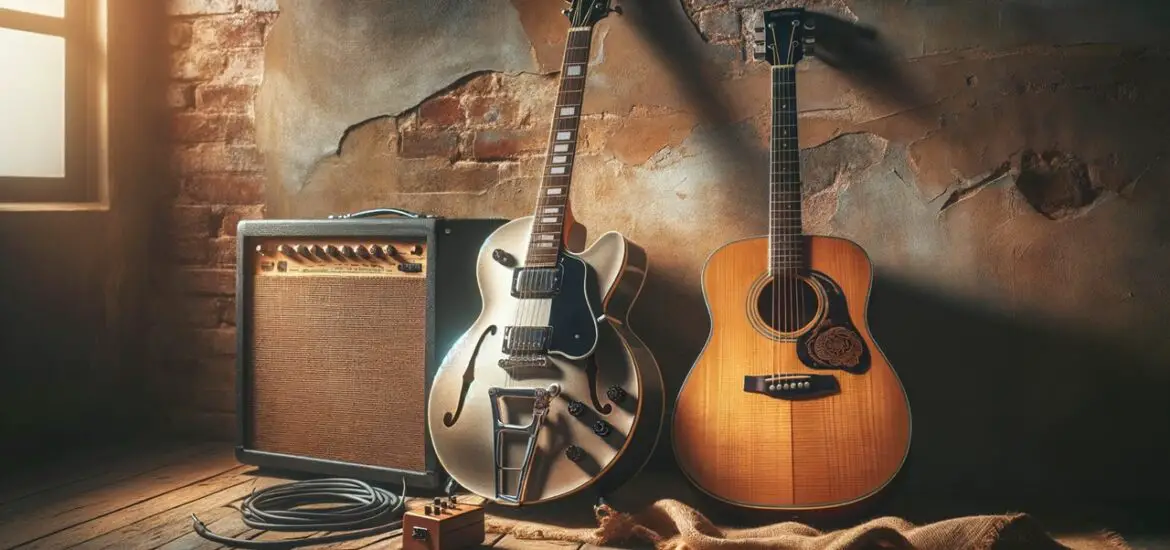When embarking on your musical journey, the first step is choosing the right instrument. If you’re wondering, ‘what guitars are best for beginners?’, you’ve come to the right place. This article will guide you through the process, ensuring a choice that aligns with your musical aspirations and needs.

Understanding Guitar Types: What Guitars Are Best for Beginners?
When beginning your musical journey, the first step is to familiarize yourself with the various types of guitars available. This understanding will help you make an informed decision about which guitar will best suit your needs and preferences.
Acoustic Guitars: The Versatile Choice for Beginners
Acoustic guitars are often recommended for beginners due to their simplicity, versatility, and ease of use. Unlike electric guitars, they do not require external amplification, making them ready to play right out of the box.
Acoustic guitars produce sound through the vibration of strings over a hollow chamber, resulting in a rich and organic tone that is suitable for a wide range of music styles, from folk and country to pop and rock.
The variety in shapes and sizes of acoustic guitars greatly influences their sound and playability. Some common types include:
Dreadnought: The Popular Choice for a Bold Sound
The Dreadnought, with its large body and broad waist, is renowned for its robust and loud sound. This shape enables a greater volume and a stronger bass response, making it ideal for strumming and flatpicking styles.
Its powerful sound projection makes it a popular choice for singer-songwriters and in ensemble settings where the guitar needs to stand out.
Concert and Grand Concert: Ideal for Fingerstyle Players
The Concert and Grand Concert guitars, smaller and more curved than the Dreadnought, offer a more controlled and focused sound.
These guitars have a lighter and more balanced tone, which complements intricate fingerpicking styles. Their smaller size also makes them more comfortable for players with a smaller frame or shorter reach.
Auditorium and Grand Auditorium: The Versatile All-Rounder
The Auditorium and Grand Auditorium guitars strike a balance between the larger Dreadnought and the smaller Concert models. These guitars have a waist that is more pronounced, allowing for a blend of the powerful sound of the Dreadnought and the nuanced tone of the Concert guitars.
They are versatile, well-suited for both strumming and fingerstyle playing, making them a great all-purpose option for diverse musical genres.
Classical Guitars: Gentle on the Finger
Classical guitars, distinct with their nylon strings, hold a special place in the world of stringed instruments. They are particularly suited for beginners, especially those with an inclination towards classical, Latin, or folk music genres.
Nylon Strings: Softer and Kinder to Fingers
The nylon strings of classical guitars are softer and exert less tension compared to the steel strings of acoustic guitars. This gentleness is much kinder on the fingers of beginners, who are yet to develop calluses and finger strength. This makes the learning process more comfortable and less daunting.
Wider Neck and String Spacing
Classical guitars typically have a wider neck and greater string spacing. This design feature provides more room between strings, facilitating ease of finger placement and making them ideal for learning fingerstyle techniques and classical guitar pieces.
Mellow and Warm Tones
The tonal quality of classical guitars is mellow and warm, distinctively different from the bright and crisp sound of steel-stringed acoustics. This tone quality is highly sought after for classical and traditional music pieces, where the nuances of the guitar’s voice can be fully appreciated.
Electric Guitars: The Sound of Rock and Blues
Electric guitars are the cornerstone of many music genres, especially rock, blues, and jazz, and they are celebrated for their versatility and distinctive playability. These instruments open up a vast landscape of sonic possibilities, making them a favorite among a wide range of musicians.
A Symphony of Sounds with Amplification and Effects
Unlike acoustic guitars, electric guitars require an amplifier to produce sound. This necessity transforms into an advantage, as it allows guitarists to experiment with a variety of tones and effects.
By using pedals and amp settings, players can add distortion for a gritty rock tone, reverb for depth and atmosphere, or delay for echo effects, broadening their musical expression.
Playability: Designed for Ease and Expression
Electric guitars are designed with playability in mind. They typically feature thinner necks and lighter gauge strings compared to acoustic guitars.
This design makes it easier to press and bend strings, facilitating techniques like fast solos, string bending, and intricate fingerwork. For beginners, this can mean a more comfortable and less physically demanding learning experience.
Iconic Designs and Tonal Diversity
Electric guitars come in a variety of designs, each with its unique tonal characteristics. Some of the most iconic models include:
Fender Stratocaster: Known for its bright, crisp tone and versatile sound, the Stratocaster is a favorite in genres ranging from blues to rock. Its distinct body shape and three-pickup configuration allow for a wide range of sounds.
Gibson Les Paul: Renowned for its rich, full sound and sustain, the Les Paul has been a staple in rock music. Its heavier body and humbucking pickups produce a warm, powerful tone that’s ideal for heavy rock and metal.
Get more answers to your guitar related questions here – Common Guitar Questions: Guide to “What” Guitar Questions
What Guitars Are Best for Beginners? – How to Pick the Right One

Now, let’s dive into how to pick the best guitar to suit you as a beginner…
Size and Comfort: Finding the Perfect Fit for Your Guitar Journey
Selecting the right size guitar is not just a matter of preference; it’s a critical factor in ensuring comfort, ease of play, and ultimately, the enjoyment and effectiveness of your practice sessions.
Full-Size Guitars: Standard Dimensions for Adult Players
Full-size guitars are the standard choice for adult players. These guitars come in various shapes, each designed to suit different playing styles and genres. For instance, a dreadnought acoustic is larger and produces a bold, loud sound, suitable for strumming.
Conversely, a concert or parlor-sized guitar is smaller, offering easier playability and a softer tone, which is excellent for fingerpicking. The key is to find a size that does not cause strain or discomfort during extended playing sessions.
Reduced-Size Guitars: A Comfortable Option for Younger or Smaller-Handed Players
Reduced-size guitars, such as ¾ size or ½ size models, are specifically designed for younger players or individuals with smaller hands. These guitars maintain the quality of sound and playability but in a more compact form.
They ensure that reaching chords and notes is not a struggle, promoting proper technique and preventing the development of bad habits.
Comfort Is Key
Physical comfort with your instrument is paramount. When trying out guitars, pay attention to how the guitar feels in your arms.
Is the neck the right width for your hand? Can your fingers easily reach the frets? Does the body of the guitar sit comfortably against your body? Your physical interaction with the guitar should feel natural and unforced.
Budget Considerations: Balancing Quality and Affordability
Setting a realistic budget for your first guitar is a balancing act between affordability and quality. While it’s understandable to be cautious about investing heavily in a new hobby, the quality of your instrument can significantly impact your learning and enjoyment.
Avoiding the Cheapest Options
The least expensive guitars might be tempting, but they often come with issues such as poor construction, low-quality materials, and inadequate sound quality. These factors can lead to a frustrating learning experience, discouraging beginners.
Investing in a Reasonably Priced Guitar
On the other hand, investing in a reasonably priced guitar from a reputable brand can enhance your learning experience.
Brands like Yamaha and Fender are known for producing quality beginner guitars that offer good sound quality, durability, and playability without breaking the bank. These guitars are built to last and can serve you well as you progress in your skills.
Finding the Middle Ground
A middle-range budget typically offers the best of both worlds: affordability and quality. Look for guitars in this range that offer solid construction, good sound quality, and comfortable playability. Remember, a quality guitar can be a long-term investment in your musical journey, making practice sessions more enjoyable and productive.
Seeking Professional Advice: Leveraging Expertise for Your Ideal Guitar
When it comes to purchasing your first guitar, the wealth of options available can be overwhelming. This is where the insights of experienced guitarists or music store professionals become invaluable.
The Benefit of Experienced Perspectives
Experienced guitarists bring years of playing and handling various guitars to the table. They can offer advice on what type of guitar might suit your musical tastes, playing style, and physical comfort.
For instance, if you’re interested in fingerstyle playing, they might recommend a classical guitar with a wider neck, which is more accommodating for this style.
Music store professionals, on the other hand, have a broad understanding of the different brands, models, and specifications of guitars suitable for beginners. They can guide you based on your budget, physical requirements, and the type of music you wish to play.
Tailored Recommendations
One of the key benefits of seeking professional advice is receiving recommendations tailored to your individual needs. They can assess factors like your hand size, musical interests, and learning goals to suggest a guitar that aligns perfectly with your personal journey.
Testing Before Purchase: Finding Your Musical Match
Testing guitars before making a purchase is a critical step in finding the instrument that’s right for you. This hands-on experience can reveal a lot about a guitar, much of which cannot be discerned from online reviews or specifications alone.
Listening to the Sound
Each guitar has its unique sound character. When testing, play a range of notes and chords to listen to the tonal quality of the guitar. Does it produce a warm, mellow sound or a bright, crisp tone? Consider the type of music you want to play and whether the guitar’s sound complements it.
Feeling the Playability
The physical feel of the guitar is just as important as its sound. Notice how it feels in your hands. Is the neck comfortable to grip? Can your fingers easily access all frets? Is the guitar’s body comfortable to hold? These aspects will significantly impact your playing experience and learning progression.
The Guitar’s Unique Character
Each guitar, even of the same model, can have slight variations that give it a unique character. This uniqueness could come from variations in wood, construction, or even string type. It’s essential to find a guitar that not only sounds good but also resonates with you on a personal level.
Conclusion: What Guitars Are Best for Beginners?
Choosing the right guitar as a beginner is a critical step in your musical journey. By understanding the different types of guitars, considering size and comfort, setting a realistic budget, seeking professional advice, and testing before buying, you can find an instrument that will be both a joy to play and a valuable tool in developing your skills.
Remember, the best guitar for you is one that fits your personal preferences and encourages you to play and learn.
